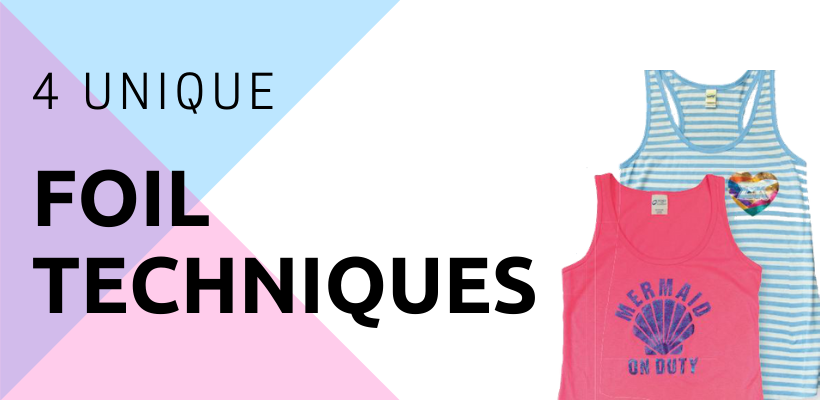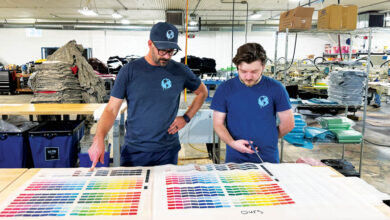With the concept and best practices of foil on vinyl down, get creative. Foil applications can be unique. Creating something new and different is the fun part of the process. Let’s review some techniques that are possible.
Multiple spot-colors in one design: Quite simple in application, try trimming the foil pieces to cover different intended parts of the artwork. Keep in mind that wherever the foil touches adhesive, it will stick. Predictable colorized areas of foil are common and quite simple to do. If using in a production environment, try to limit any areas of tight foil placement relative to another color, as this can be challenging.
Intricate multi-color prints: While a predictable result is sellable, an abstract pattern made of foil colors is increasingly popular for fashion-forward customers. Try cutting the foil into pieces and strips layering each on top of the applied-adhesive design in a random sequence until everything is covered, and then apply with your heat press. The result will be unique each time.
Multi-color distressed prints: Creating two-color distressed effects with foil is very easy. First, crumble up the primary color of foil into a ball. Then, flatten it out a bit to lay over the adhesive for heat application. After pressing and peeling, there will be distressed areas where the adhesive is still exposed. Take a complementary color of foil and lay it flat over the top of the entire design. Take another piece of foil and complete one additional application. This layer will fill all of the void areas to create a unique two-tone, distressed print. You can also try altering distressed levels by how much you crumble up the initial foil layer until you get your intended result.
Mixed-media foil prints: Combining foil with other heat-transfer vinyl finishes creates a great look, but it can be challenging. The foil has the potential to stick to the other heat-transfer vinyl that it contacts when applied. Test how foil will react with your HTV before beginning production. Foil typically will not stick to glitter flake and flock vinyl, making them ideal to use. Just be sure to reach the melting point of the highest temperature heat transfer for its recommended time. For instance, if glitter applies at 320 degrees F for 15 seconds and foil requires 300 degrees F for 10 seconds, ensure that, at some point, the glitter flake receives its temperature and time. Consider the sequence of the application as well, so the foil is the last step, if possible. This order will help keep its mirror-like finish.
With a basic understanding of how foil works, innovation is not only possible but plausible. Think not only of basic sales opportunities but how your business can benefit from looks that cannot be duplicated by competitors.




